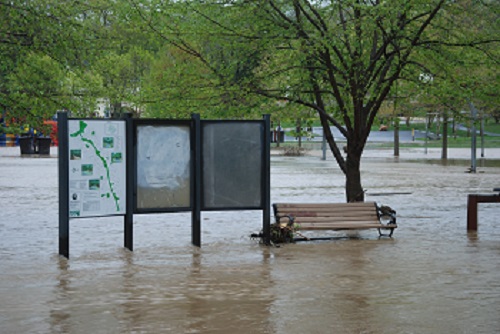Mattapoisett rallies to prepare for weather ahead
By Amy Miller
Jeri Weiss, a drinking water specialist at EPA New England, has been working with the people of Mattapoisett this year, making trips and calls to this southeastern Massachusetts town sitting on the edge of Buzzards Bay. Weiss has consulted with officials and residents about the best ways to  prepare for climate change, and she has seen what a community can do when its best minds work together.
prepare for climate change, and she has seen what a community can do when its best minds work together.
Recently, Jeri made the trip down the coast with Regional Administrator Curt Spalding. She hoped that he too could get a look at how Mattapoisett’s officials and Boy Scouts, educators and planners and citizens have come together to help ensure Mattapoisett will weather the weather ahead.
Accompanied by Jane Downing, chief of EPA’s drinking water program, Spalding met with the fire and police chief, the town manager, the water supervisor and citizens, including Nick Nicholson, former town drinking water superintendent, all of whom were proud to present their work.
“It meant a lot to me that [Curt and others from EPA] took the time to come to our town,” said Nicholson in a follow-up note to Jeri.
Because its pumping station is at sea level, Mattapoisett’s wastewater and drinking water systems may be at great risk if, or when, heavy rains come or sea levels rise. The town has been able to take advantage of funding provided by EPA’s Regional Applied Research and Regional Sustainable Environmental Research programs. These funds are allowing Mattapoisett to look at its challenges and identify actions to take if an evacuation was needed.
As project manager, Jeri worked with the town to make sure the community played a part in coming up with solutions.
“This community is so unbelievably fantastic,” Jeri said. “They really took on this project and ran with it.”
One of the things a core group of townspeople did as soon as the project began was to collect stories and pictures of how the town reacted to past extreme weather conditions. Community members were happy to tell their stories and share their memories. Curt heard from them how water flowed over the Route 6 dam during Hurricane Bob in 1991, inundating a drinking water well field. And he was told about a video the town is creating in which more than a dozen people, many in their 80s and 90s, recall how hard the town was hit in the 1938 hurricane.
In another video being produced by the local cable TV station, Old Rochester Cable TV, police and fire officials warn townspeople about how important it is to be prepared and to have evacuation plans in place.
While Boy Scouts in other towns may be forging trails or building benches, Boy Scout Jared Watson in Mattapoisett is helping his community envision their world after a major flood. The visualization, an Eagle Scout project, involves putting rings on utility poles to show how high water reached in past floods.
The Cable TV station has assigned an intern to take pictures comparing different spots before and after storms. And employees at the library, a beautifully rebuilt historic building where Curt met with the community, are collecting information on flooding and preparedness and putting up displays.
EPA’s role in this is to offer Mattapoisett options for protecting their drinking and wastewater plants – perhaps a wall, or relocation, or modifications on existing infrastructure. The point is to give the town alternatives.
From Jeri’s point of view, Mattapoisett is a model for how communities can work together to prepare.
As impressive as all the planning is, she found the attitude of the town leaders most extraordinary. Town Manager Mike Gagne told her Mattapoisett’s water and wastewater assets are important, but it’s the town’s people that really impress him.
“That,” said Jeri said, “is both admirable and true.”
-30-
Amy Miller is in the Office of Public Affairs at EPA’s New England office.
For more about climate adaptations in Mattapoisett:
http://buzzardsbayaction.org/BBAC_CZM-Resilience-Grants_01282016.pdf








